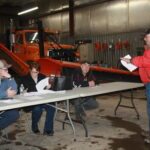Today the ideal family size is two parents and two children, but years ago families were much larger. In my research I’ve frequently encountered families with 15 or more children.
The record is held by a man who fathered 21 children. Admittedly, his first wife “only” bore 19 and his second wife two, but the idea of a man siring 21 children is looked on askance today. What did the man with 21 children to support do for a living? He was a common laborer, though I fear it was his first wife who did most of the laboring.
Prior to the advent of modern medicine, parents were fortunate if all of their children lived to adulthood. Common diseases such as measles, mumps, diphtheria, typhoid fever, pneumonia, and others thinned the ranks of children and often their mothers, as well, who died while nursing their sick children. I once found a newspaper notice of a man who’d lost four children and his wife in one week. It was an unspecified disease raging its way through his neighborhood in Atkinson. Imagine five coffins of various sizes in your parlor.
The anticipated loss of children meant families compensated by having many children so they could count on some surviving. It didn’t always work, as sometimes families lost all their children to communicable diseases.
When you come upon a family with many children it is easy to wonder about the wives. Women often died in childbirth, sometimes taking their babies with them. Many women died shortly after giving birth. Women giving birth were always in danger of death. They were vulnerable to hemorrhages and infections, usually lumped under the name “puerperal fever.” Often it was an infection caught from the unwashed hands of a doctor or inexperienced midwives.
Women also had to cope with miscarriages and stillbirths. And women’s fertility periods were quite long. It was fairly common that a woman in her late 40s would be giving birth when her oldest daughters were already mothers themselves.
Let’s look at a typical 18th-century family. The Reverend Samuel Woodward of Brunswick fathered 12 children with his first wife, Mary Coombs, and five more with his second wife, Ann Woodside. Samuel and Mary lost their first two children, Nathan and Judah, who each lived less than a year. Mary died two months after giving birth to her 12th child, a daughter.
The reverend’s second wife, Ann, bore him five children. The last, Lavinia, died when she was 2 years old. I haven’t been able to account for two of Samuel’s known children, so it is possible they died young as well.
Keep in mind that in addition to childhood diseases, factors such as poor sanitation, uncertain hygiene, food shortages, unclean water supplies, severe winters, crowded living conditions and poor medical care entered into the death rates of children into the 20th century. However, the children of the rich were just as vulnerable to communicable diseases as the poor. These diseases never differentiated to a child’s status.
Columnist Nancy Battick of Dover-Foxcroft has researched genealogy for over 30 years. She is past president of the Maine Genealogical Society, author of several genealogical articles and co-transcribed the Vital Records of Dover-Foxcroft. Nancy holds an MA in History from UM and lives in DF with her husband, Jack, another avid genealogist. Reader emails are welcome at nbattick@roadrunner.com.







